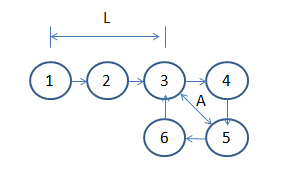问题:如何判断单链表是否有环?如何找到环的起始点?如何知道环的长度。
方法:使用快慢指针法,即快指针每次移动两个节点,慢指针每次移动一个节点
(1)判断是否有环
如图所示,假设有两个节点fast,slow分别指向链表头,即图中的节点1所在的地址。然后令
然后循环执行知道slow等于fast时,即可推断出环的存在。注意循环条件为fast != NULL && fast->next != NULL。slow = slow->next; fast = fast->next->next;代码如下所示:
#include <stdio.h> #include <stdlib.h> typedef struct node { int data; struct node * next; }Node; Node * get_circle_link(int length, int local) { Node *temp = NULL; Node *phead = NULL; Node *tail = NULL; int i; //创建单链表 for (i = 0; i < length; i++) { temp = (Node *)malloc(sizeof(Node)); temp->next = NULL; temp->data = length - i; if (phead == NULL) { tail = temp; } temp->next = phead; phead = temp; } //形成环 for (temp = phead, i =1; i < local; i++) { temp = temp->next; } tail->next = temp; return phead; } void link_print(Node *temp) { while (temp != NULL) { printf("%p:%d\t",temp,temp->data); temp = temp->next; getchar(); } } //利用快慢指针判断链表是否有环 int get_circle_local(Node *phead) { Node * fast = phead; Node * slow = phead; while (fast != NULL && fast->next != NULL) { fast = fast->next->next; //fast一次跳两个节点 slow = slow->next; //slow一次跳一个节点 if (fast == slow) { return 1; } } return 0; } int main() { Node * phead = NULL; int local = 0; int number = 0; scanf("%d",&number); //链表的节点数 scanf("%d",&local); //链表环的节点数 if (number < local || local <= 0 || number <= 0) { printf("number MUST >= local, and MUST be positive integer\n"); exit(EXIT_FAILURE); } phead = get_circle_link(number,local); //link_print(phead); int ret = 0; if (get_circle_local(phead) == 1) { printf("has circle\n"); } else printf("no circle\n"); return 0; }
输入:6 3
运行结果:
(2) 寻找环的起始点
假设节点1到节点3距离为L,而节点3到节点5的距离为A,则有L + A = (L + A + N*X)/2,其中N为快捷点与慢节点相遇时走过的多少个环,X为1个环的环数。
因此,当判断fast=slow时,将slow和fast节点的步长都改为1步,即
slow = slow->next; fast = fast->next;当slow再次等于fast时,相遇的节点即为起始点
程序为:
输入:6 4#include <stdio.h> #include <stdlib.h> typedef struct node { int data; struct node * next; }Node; Node * get_circle_link(int length, int local) { Node *temp = NULL; Node *phead = NULL; Node *tail = NULL; int i; //创建单链表 for (i = 0; i < length; i++) { temp = (Node *)malloc(sizeof(Node)); temp->next = NULL; temp->data = length - i; if (phead == NULL) { tail = temp; } temp->next = phead; phead = temp; } for (temp = phead, i =1; i < local; i++) { temp = temp->next; } tail->next = temp; return phead; } void link_print(Node *temp) { while (temp != NULL) { printf("%p:%d\t",temp,temp->data); temp = temp->next; getchar(); } } //利用快慢指针判断链表是否有环 int get_circle_local(Node *phead) { Node * fast = phead; Node * slow = phead; while (fast != NULL && fast->next != NULL) { fast = fast->next->next; //fast一次跳两个节点 slow = slow->next; //slow一次跳一个节点 if (fast == slow) { //return 1; for (slow = phead; slow != fast;) { slow = slow->next; fast = fast->next; } return slow->data; } } return 0; } int main() { Node * phead = NULL; int local = 0; int number = 0; scanf("%d",&number); //链表的节点数 scanf("%d",&local); //链表环的节点数 if (number < local || local <= 0 || number <= 0) { printf("number MUST >= local, and MUST be positive integer\n"); exit(EXIT_FAILURE); } phead = get_circle_link(number,local); //link_print(phead); int ret = 0; if ((ret = get_circle_local(phead)) > 0) { printf("has circle,local is %d\n",ret); } else printf("no circle\n"); return 0; }结果为:
(3)判断环的长度
当判断链表有环(slow==fast)时,设置fast的步长为2,slow的步长为1,即
slow = slow->next; fast = fast->next->next;当下次再次相遇时,两者的走过的距离差即为环的长度。
<span style="font-size:18px;">程序如下:</span><pre name="code" class="cpp">#include <stdio.h> #include <stdlib.h> typedef struct node { int data; struct node * next; }Node; Node * get_circle_link(int length, int local) { Node *temp = NULL; Node *phead = NULL; Node *tail = NULL; int i; //创建单链表 for (i = 0; i < length; i++) { temp = (Node *)malloc(sizeof(Node)); temp->next = NULL; temp->data = length - i; if (phead == NULL) { tail = temp; } temp->next = phead; phead = temp; } for (temp = phead, i =1; i < local; i++) { temp = temp->next; } tail->next = temp; return phead; } void link_print(Node *temp) { while (temp != NULL) { printf("%p:%d\t",temp,temp->data); temp = temp->next; getchar(); } } //利用快慢指针判断链表是否有环 int get_circle_local(Node *phead) { Node * fast = phead; Node * slow = phead; int temp = 0; while (fast != NULL && fast->next != NULL) { fast = fast->next->next; //fast一次跳两个节点 slow = slow->next; //slow一次跳一个节点 if (fast == slow) { while (fast != NULL && fast->next != NULL) { fast = fast->next->next; slow = slow->next; temp++; if (fast == slow) { return temp; } } } } return 0; } int main() { Node * phead = NULL; int local = 0; int number = 0; scanf("%d",&number); //链表的节点数 scanf("%d",&local); //链表环的节点数 if (number < local || local <= 0 || number <= 0) { printf("number MUST >= local, and MUST be positive integer\n"); exit(EXIT_FAILURE); } phead = get_circle_link(number,local); //link_print(phead); int ret = 0; if ((ret = get_circle_local(phead)) > 0) { printf("has circle,local is %d\n",ret); } else printf("no circle\n"); return 0; }
输入:6 4运行结果为:<img src="https://img-blog.csdn.net/20140913223547183" alt="" />
链表的环问题
最新推荐文章于 2023-03-16 21:36:49 发布
 本文详细介绍了如何使用快慢指针法判断单链表是否有环,如何找到环的起始点,以及如何计算环的长度。通过具体实例演示了实现过程,并提供了关键代码片段。
本文详细介绍了如何使用快慢指针法判断单链表是否有环,如何找到环的起始点,以及如何计算环的长度。通过具体实例演示了实现过程,并提供了关键代码片段。


























 1694
1694

 被折叠的 条评论
为什么被折叠?
被折叠的 条评论
为什么被折叠?










